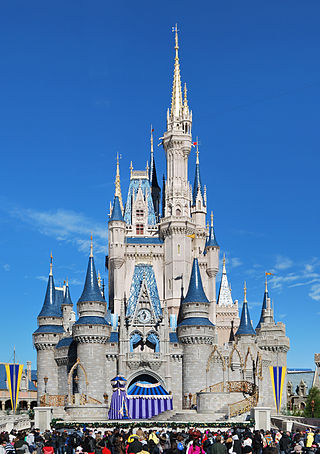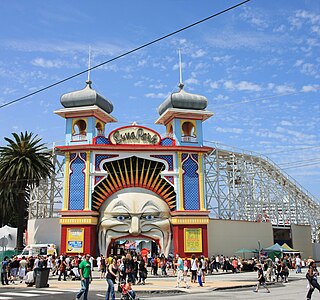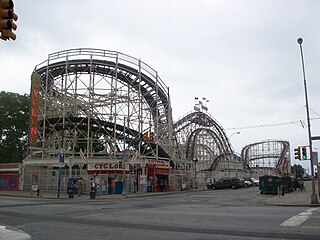
An amusement park is a park that features various attractions, such as rides and games, as well as other events for entertainment purposes. A theme park is a type of amusement park that bases its structures and attractions around a central theme, often featuring multiple areas with different themes. Unlike temporary and mobile funfairs and carnivals, amusement parks are stationary and built for long-lasting operation. They are more elaborate than city parks and playgrounds, usually providing attractions that cater to a variety of age groups. While amusement parks often contain themed areas, theme parks place a heavier focus with more intricately-designed themes that revolve around a particular subject or group of subjects.

A roller coaster, or rollercoaster, is a type of amusement ride that employs a form of elevated railroad track designed with tight turns, steep slopes, and sometimes inversions. Passengers ride along the track in open cars, and the rides are often found in amusement parks and theme parks around the world. LaMarcus Adna Thompson obtained one of the first known patents for a roller coaster design in 1885, related to the Switchback Railway that opened a year earlier at Coney Island. The track in a coaster design does not necessarily have to be a complete circuit, as shuttle roller coasters demonstrate. Most roller coasters have multiple cars in which passengers sit and are restrained. Two or more cars hooked together are called a train. Some roller coasters, notably Wild Mouse roller coasters, run with single cars.

Coney Island is a peninsular neighborhood and entertainment area in the southwestern section of the New York City borough of Brooklyn. The neighborhood is bounded by Brighton Beach and Manhattan Beach to its east, Lower New York Bay to the south and west, and Gravesend to the north and includes the subsection of Sea Gate on its west. More broadly, the Coney Island peninsula consists of Coney Island proper, Brighton Beach, and Manhattan Beach. This was formerly the westernmost of the Outer Barrier islands on the southern shore of Long Island, but in the early 20th century it became a peninsula, connected to the rest of Long Island by land fill.

The generic roller coaster vertical loop, where a section of track causes the riders to complete a 360 degree turn, is the most basic of roller coaster inversions. At the top of the loop, riders are completely inverted.

Luna Park was an amusement park in Coney Island, Brooklyn, New York City. The park was located on a site bounded by Surf Avenue to the south, West 8th Street to the east, Neptune Avenue to the north, and West 12th Street to the west. Luna Park opened in 1903 and operated until 1944. It was located partly on the grounds of the small park it replaced, Sea Lion Park, "the first enclosed and permanent amusement park in North America", which had operated between 1895 and 1902. It was the second of the three original, very large, iconic parks built on Coney Island; the other were Steeplechase Park and Dreamland. At Coney Island's peak in the middle of the 20th century's first decade, the three amusement parks competed with each other and with many independent amusements.

Steeplechase Park was a 15-acre (6.1 ha) amusement park in Coney Island, Brooklyn, New York City. Steeplechase Park was created by entrepreneur George C. Tilyou in 1897 and operated until 1964. It was the first of the three large amusement parks built on Coney Island, the other two being Luna Park (1903) and Dreamland (1904). Of the three, Steeplechase was the longest-lasting, running for 67 years.

Luna Park is a name shared by dozens of currently operating and defunct amusement parks. They are named after, and partly based on, the first Luna Park, which opened in 1903 during the heyday of large Coney Island parks. Luna parks are small-scale attraction parks, easily accessed, potentially addressed to the permanent or temporary residential market, and located in the suburbs or even near the town center. Luna parks mainly offer classic funfair attractions, newer features and catering services.

A roller coaster train is a vehicle made up of two or more cars connected by specialized joints which transports passengers around a roller coaster's circuit. Roller coasters usually have various safety features, including specialized wheels and restraints.

Luna Park Melbourne is a historic amusement park located on the foreshore of Port Phillip Bay in St Kilda, Melbourne, Victoria. It opened on 13 December 1912, with a formal opening a week later, and has been operating almost continuously ever since.

The Cyclone, also the Coney Island Cyclone, is a wooden roller coaster at Luna Park in Coney Island, Brooklyn, New York City. Designed by Vernon Keenan, it opened to the public on June 26, 1927. The roller coaster is on a plot of land at the intersection of Surf Avenue and West 10th Street. The Cyclone reaches a maximum speed of 60 miles per hour (97 km/h) and has a total track length of 2,640 feet (800 m), with a maximum height of 85 feet (26 m).

Soarin' Eagle is a steel roller coaster located at the Scream Zone at Luna Park in Coney Island, Brooklyn, New York. The ride was the first ever Zamperla "Volare" roller coaster when it opened in 2002 at Elitch Gardens in Denver, Colorado, as the Flying Coaster. The Elitch Gardens ride was constructed by Martin & Vleminckx. The Volare, the cheapest option for a flying roller coaster, contains a compact layout with a distinctive spiral lift hill. In late 2010 the ride got dismantled and relocated to Luna Park in Coney Island, where it opened in April 2011 as the Soarin' Eagle. The ride has an identical sister, Hero, which opened in July 2013 at Flamingo Land in North Yorkshire.

The Racer is a wooden, racing roller coaster located at Kings Island amusement park in Mason, Ohio. It was designed by John C. Allen, well-known for his contributions to roller coasters during the mid-twentieth century, and debuted at the park's grand opening in 1972. It was thrust into the national spotlight after being featured in an episode of the popular TV sitcom The Brady Bunch in 1973 and is often recognized for playing a vital role in the roller coaster renaissance of the 1970s. The Racer inspired similar designs in other roller coasters, such as Racer 75 at Kings Dominion and the now-defunct Thunder Road at Carowinds. The Racer is also one of the few original Kings Island attractions still in operation today.

Astroland was a 3.1-acre (1.3 ha) amusement park in Coney Island, Brooklyn, New York City that first opened in 1962. It was located at 1000 Surf Avenue on the boardwalk. It ceased operations on September 7, 2008.

Roller coaster amusement rides have origins back to ice slides constructed in 18th-century Russia. Early technology featured sleds or wheeled carts that were sent down hills of snow reinforced by wooden supports. The technology evolved in the 19th century to feature railroad track using wheeled cars that were securely locked to the track. Newer innovations emerged in the early 20th century with side friction and underfriction technologies to allow for greater speeds and sharper turns. By the mid-to-late 20th century, these elements intensified with the introduction of steel roller coaster designs and the ability to invert riders.
Frederick Ingersoll was an American inventor, designer, builder and entrepreneur who created the world's first chain of amusement parks and whose manufacturing company built 277 roller coasters, fueling the popularity of trolley parks in the first third of the twentieth century. Some of these parks and roller coasters still exist today.
White City is the common name of dozens of amusement parks in the United States, the United Kingdom, and Australia. Inspired by the White City and Midway Plaisance sections of the World's Columbian Exhibition of 1893, the parks started gaining in popularity in the last few years of the 19th century. After the 1901 Pan-American Exposition inspired the first Luna Park in Coney Island, a frenzy in building amusement parks ensued in the first two decades of the 20th century.

Luna Park is an amusement park in Coney Island, Brooklyn, New York City. It opened on May 29, 2010, at the site of Astroland, an amusement park that had been in operation from 1962 to 2008, and Dreamland, which operated at the same site for the 2009 season. It was named after the original 1903 Luna Park which operated until 1944 on a site just north of the current park's 1000 Surf Avenue location.

Flip Flap Railway was the name of a looping wooden roller coaster which operated for a number of years at Paul Boyton's Sea Lion Park on Coney Island in Brooklyn, New York. The coaster, which opened in 1895, was one of the first looping roller coasters to operate in North America. It was also notable for its engineering as well as the extreme G-forces that this engineering inflicted on riders.

Thunderbolt is a steel roller coaster at Luna Park in Coney Island, Brooklyn, New York City. It is located near Surf Avenue and West 15th Street, on the Riegelmann Boardwalk next to the B&B Carousell.

Cannon Coaster, sometimes known as Leap-the-Gap, was a wooden roller coaster which operated on Bowery Street in Coney Island, Brooklyn, New York, in the first decade of the 20th century.




















